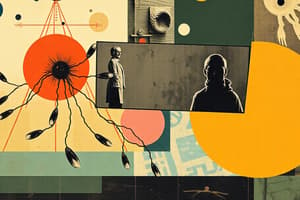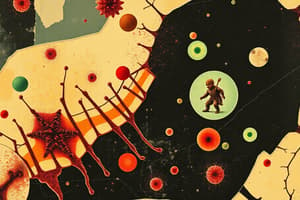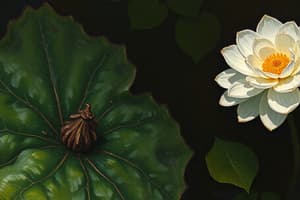Podcast
Questions and Answers
All living things start as a single ______.
All living things start as a single ______.
cell
Unicellular organisms are made of ______ cell while multicellular organisms are made of multiple cells.
Unicellular organisms are made of ______ cell while multicellular organisms are made of multiple cells.
one
______ is the ability to maintain internal stability despite external changes.
______ is the ability to maintain internal stability despite external changes.
Homeostasis
Organisms that create their own food through natural processes are called ______.
Organisms that create their own food through natural processes are called ______.
The process of producing offspring is known as ______.
The process of producing offspring is known as ______.
In sexual reproduction, two types of cells, sperm and ______, are required.
In sexual reproduction, two types of cells, sperm and ______, are required.
The theory of ______ explains how organisms adapt to their environment over generations.
The theory of ______ explains how organisms adapt to their environment over generations.
All cells contain ______, which carries genetic information.
All cells contain ______, which carries genetic information.
Flashcards
Growth and Development
Growth and Development
A fundamental characteristic of living organisms, encompassing growth and development. Growth refers to an increase in the amount of living material, typically through an increase in the number of cells. Development involves changes in the organism's structure and function, often resulting in specialization of cells and tissues.
Homeostasis
Homeostasis
The process by which organisms maintain a stable internal environment despite changes in the external environment. This includes regulating factors like temperature, water balance, and blood sugar.
Autotrophs
Autotrophs
Organisms that can produce their own food through natural processes, typically using sunlight or chemical energy. They are the foundation of most ecosystems.
Heterotrophs
Heterotrophs
Signup and view all the flashcards
Reproduction
Reproduction
Signup and view all the flashcards
Asexual reproduction
Asexual reproduction
Signup and view all the flashcards
Sexual reproduction
Sexual reproduction
Signup and view all the flashcards
Evolution
Evolution
Signup and view all the flashcards
Study Notes
Characteristics of Life
-
Growth and Development: All living things begin as a single cell. Growth is an increase in the amount of living material (cells) – a quantitative change. Development is a qualitative change, involving cell differentiation and tissue specialization (metamorphosis). Both growth and development occur throughout the life of an organism, even in single-celled organisms.
-
Made of Cells: All living organisms are composed of cells. Cells are the basic units of life. There are two main types of cells: prokaryotic and eukaryotic. All cells contain DNA.
-
Levels of Organization: Living things exhibit a hierarchical structure. Starting with atoms and molecules (non-living), the levels of organization include cells, tissues, organs, organ systems, organisms, populations, communities, ecosystems, and biomes.
Responding to Stimuli
- Homeostasis: Living organisms maintain a stable internal environment despite external changes. This is a crucial life process. Homeostasis is reflected by physiological responses such as sweating, shivering, and digestive processes. External stimuli include temperature changes, sounds, or physical contact. Internal changes like temperature fluctuations or nutrient deficiencies are also regulated to maintain homeostasis.
Requiring Energy
-
Autotrophs: Organisms that produce their own food using natural processes, mainly utilizing solar energy (phototrophs). A different group, chemotrophs, create energy from chemical reactions. Not all autotrophs use photosynthesis, but all phototrophs use photosynthesis.
-
Heterotrophs: Organisms that obtain energy by consuming other organisms (or dead organic material). Different types include herbivores, carnivores, omnivores, detritivores (feeding on dead organisms), and decomposers. All heterotrophs use cellular respiration to obtain energy.
Reproduction and Evolution
-
Reproduction: The creation of offspring. While essential for the survival of a species, reproduction isn't necessary for an individual organism's survival.
-
Asexual Reproduction: A single organism creates offspring without the need for another.
-
Sexual Reproduction: Involves two parent organisms contributing genetic material (sperm and egg).
-
Evolution: The process of adaptation and change over time by which organisms adapt to their environment, impacting future generations' DNA. This results in the survival of the fittest. Extinction occurs when a species disappears completely.
Studying That Suits You
Use AI to generate personalized quizzes and flashcards to suit your learning preferences.
Description
Test your knowledge on the fundamental characteristics of life, including growth, cellular organization, and homeostasis. This quiz covers essential concepts vital for understanding biology and living organisms. Perfect for students studying life sciences.




